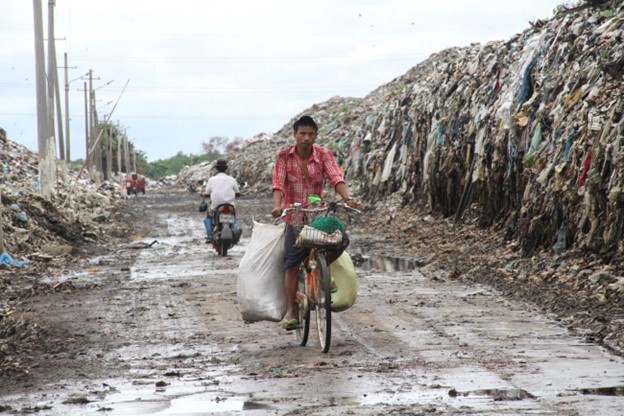The projection for municipal solid waste (MSW) generation indicates a significant rise, reaching an estimated 3.4 billion tons by 2050. Unfortunately, this notable increase in waste production is accompanied by various mismanagement issues. These problems encompass inadequate adherence to the essential principles of the 3R approach (reduce, reuse, recycle), inefficient waste transportation and collection systems, and inappropriate waste closure techniques. (1)
The US Environmental Protection Agency (US. EPA) defines an open dumpsite as an illicit disposal site where solid waste is carelessly discarded, posing potential threats to human well-being and the environment. Open dumpsite typically manifests as abandoned heaps of refuse that attract disease-carrying organisms like rodents and insects and hold the potential to give rise to air pollution-related damage and contamination of groundwater and runoff.
Although open dumpsites might offer a seemingly inexpensive solution for waste disposal, they come with many significant disadvantages. These drawbacks include the creation of health hazards due to the proliferation of insects and rodents, the potential for damage stemming from air pollution, and the introduction of pollutants into groundwater and runoff systems. (2)
The quantity of generated solid waste naturally surges in areas experiencing a steady influx of urban residents. Over time, this waste undergoes slow aerobic and anaerobic decomposition processes, yielding substantial quantities of leachate. This leachate contains decomposed byproducts, heavy metals, and various hazardous contaminants. Of particular concern is the potential for these substances to infiltrate underground aquifers, posing a considerable challenge to both environmental and human well-being.
Some dumpsite practices (e.g., in Myanmar) are as follows:
- Controlled Dumping: Waste is disposed of without adequate protection but in a controlled manner. The operation includes occasional soil covering, bulldozing of waste piles, and rudimentary leachate collection. This practice is common in larger towns, and the relevant authorities manage it.
- Open-air Burning: The practice involves the uncontrolled burning of stored waste at dumpsites to reduce waste volume. Waste is burned regularly, either continuously, after waste delivery, or weekly. It is ignited by waste workers or scavengers at the dumpsite.
- Leaking Dumps: These are designated dumpsites where solid waste regularly leaks into the environment. This typically occurs because these dumpsites are located on mountain slopes or near waterways.
- Uncollected (Illegal) Dumping: The community discards waste freely without centralized management. This includes practices like household burning and direct disposal of waste into waterways or unused land. This type of waste disposal is prevalent in village tracts and small river towns. (3)
Developing countries often confront the challenge of open dumpsites due to financial limitations and a shortage of trained personnel. Unfortunately, these practices are exacerbated by inadequate governmental policies. (4,5) As a result, open dump incidents in the ASEAN region have given rise to notable environmental, health, and safety concerns. The combination of inadequate waste management practices, insufficient infrastructure, and high population density contributes to such incidents. Noteworthy examples of open dump incidents within ASEAN include:
- Payatas Tragedy, Philippines (July 2000): The collapse of a massive garbage heap at the Payatas open dumpsite in Quezon City resulted in a tragic landslide. This disaster claimed the lives of approximately 200 people, many of whom were informal waste pickers and their families.
- Leuwigajah Disaster, Indonesia (February 2005): The Leuwigajah dumpsite near Bandung experienced a massive waste slide, causing a devastating landslide. The incident resulted in the loss of 147 lives and extensive damage to nearby settlements. (6)
Therefore, a comprehensive and well-managed SWM (Solid Waste Management) system is crucial for minimizing environmental impacts, promoting public health, and ensuring the sustainable management of waste. To overcome the challenges of the unaware open dump practices, the following practices should be considered; (i) improving waste collection and selective collection coverage of municipal areas, (ii) introducing awareness and information campaigns, (iii) implementing appropriate treatment systems with regulations and control agencies,(iv) improving final disposal sites and its management, (v) enhancing financial sustainability of the systems and(vi) introducing future management plans are all practices required for improving the integrated SWM system of a country, region, municipality or rural area. (7)
Ref:
- A. Budihardjo et al., 2023, “Strategies to reduce greenhouse gas emissions from municipal solid waste”, Alexandria Engineering Journal (2023) 69, 771–783
- https://www.gdrc.org/uem/waste/disposal.html
- https://www.thantmyanmar.com/sites/thantmyanmar.com/files/documents-file/diggingthrough_final_draft.pdf
- Adedinni, M.O., Arogundade, A.B., Ore, O.T. et al. “Geophysical and geochemical study of the contaminant impact of Oke-Tage solid waste dumpsite, Southwestern Nigeria“. Sci Rep 13, 4704 (2023). https://doi.org/10.1038/s41598-023-31948-3
- M. Ali et al. (2014), “Open dumping of municipal solid waste and its hazardous impacts on soil and vegetation diversity”, Journal of King Saud University – Science (2014) 26, 59–65
- Michikazu Kojima, “Toward Regional Cooperation of Local Governments in ASEAN”, ERIA Collaborative/Support Research Report, IDE-JETRO, 2019
- Ferronato N, Torretta V. Waste Mismanagement in Developing Countries: A Review of Global Issues. Int J Environ Res Public Health. 2019 Mar 24;16(6):1060. doi: 10.3390/ijerph16061060. PMID: 30909625; PMCID: PMC6466021.
By: Moe Thazin Shwe, SOLEN Research Associate – IPC panel member
Edited by: Hendra WINASTU, SOLEN Principal Associate – IPC panel coordinator
Date: 10 August 2023
Article#: SOLEN-IPC-0023



 Tiếng Việt
Tiếng Việt 日本語
日本語
Pingback: Nickel mine and its impact - SOLEN- IPC-024 - Solen
Pingback: Mỏ Niken và tác động của nó - SOLEN- IPC-024 - SOLEN
Pingback: ニッケル鉱山とその影響 - SOLEN- IPC-024 - Solen